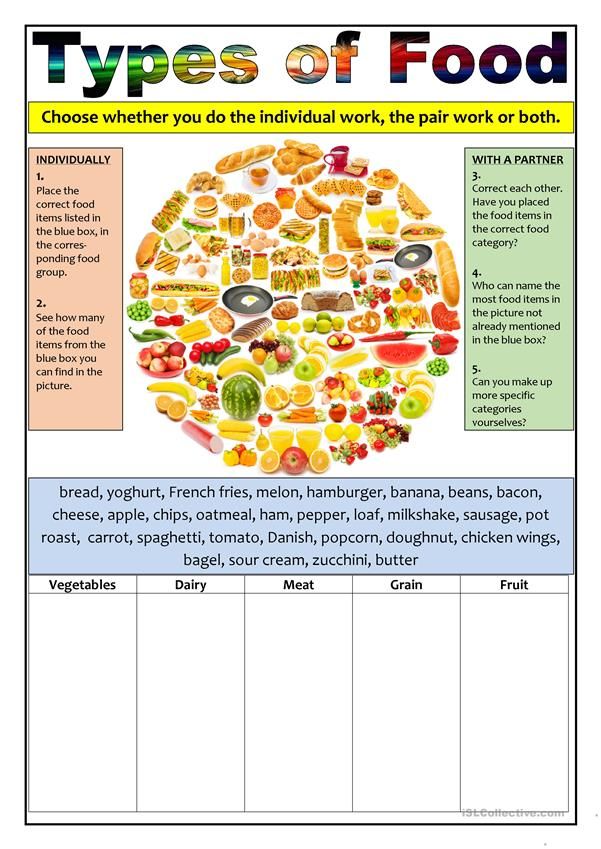Amount of food for babies
How Often and How Much Should Your Baby Eat?
By: Sanjeev Jain, MD, FAAP
One of the most common questions new parents have is how often their baby should eat. The best answer is surprisingly simple: in general, babies should be fed whenever they seem hungry.
How do I know when my baby is hungry?
For babies born
prematurely or with certain medical conditions, scheduled feedings advised by your pediatrician are best. But for most healthy, full-term infants, parents can look to their baby rather than the clock for hunger cues. This is called feeding on demand, or
responsive feeding.
Hunger cues
A hungry baby often will cry. But it's best to watch for hunger cues before the baby starts crying, which is a late sign of hunger and can make it hard for them to settle down and eat.
Some other typical hunger cues in babies:
Licking lips
Sticking tongue out
Rooting (moving jaw and mouth or head in search of breast)
Putting his/her hand to mouth repeatedly
Opening her mouth
Fussiness
Sucking on everything around
It is important to realize, however, that every time your baby cries or sucks it is not necessarily because he or she is hungry. Babies suck not only for hunger, but also for comfort; it can be hard at first for parents to tell the difference. Sometimes, your baby just needs to be cuddled or changed.
General guidelines for baby feeding
It is important to remember all babies are different―some like to snack more often, and others drink more at one time and go longer between feedings. However, most babies will drink more and go longer between feedings as they get bigger and their tummies can hold more milk:
Most newborns eat every 2 to 3 hours, or 8 to 12 times every 24 hours. Babies might only take in half ounce per feeding for the first day or two of life, but after that will usually drink 1 to 2 ounces at each feeding. This amount increases to 2 to 3 ounces by 2 weeks of age.
At about 2 months of age, babies usually take 4 to 5 ounces per feeding every 3 to 4 hours.
At 4 months, babies usually take 4 to 6 ounces per feeding.

At 6 months, babies may be taking up to 8 ounces every 4 to 5 hours.
Most babies will increase the amount of formula they drink by an average of 1 ounce each month before leveling off at about 7 to 8 ounces per feeding. Solid foods should be started at about 6 months old.
Concerns about overfeeding or underfeeding your baby
Too full?
Babies are usually pretty good at eating the right amount, but they can sometimes take in more than they need. Infants who are bottle feeding may be more likely to overfeed, because drinking from a bottle may take less effort than breastfeeding.
Overfed babies can have stomach pains, gas, spit up or vomit and be at higher risk for obesity later in life. It's better to offer less, since you can always give more if your baby wants it. This also gives babies time to realize when they're full.
If you are concerned your baby wants to eat
all the time―even when he or she is full―talk with your pediatrician. Pacifiers may be used after feeding to help sooth healthy-weight babies who like to suck for comfort, rather than nutrition. For babies who are breastfed, it's best to wait to offer pacifiers until around 3 to 4 weeks of age, when breastfeeding is well-established.
Pacifiers may be used after feeding to help sooth healthy-weight babies who like to suck for comfort, rather than nutrition. For babies who are breastfed, it's best to wait to offer pacifiers until around 3 to 4 weeks of age, when breastfeeding is well-established.
Trouble gaining weight?
Most babies will double their birth weight by 5 months of age and triple their birth weight by their first birthday. If your baby is having trouble gaining weight, don't wait too long between feeding―even if it means waking your baby. Be sure to talk with your pediatrician about how often and how much to feed your baby.
How do I know if my baby is getting enough to eat?
Daily diapers
A newborn's
diaper is a good indicator of whether he or she is getting enough to eat. In the first few days after birth, a baby should have 2 to 3 wet diapers each day. After the first 4 to 5 days, a baby should have at least 5 to 6 wet diapers a day. Stool frequency is more variable and depends whether your baby is
breastfed or formula fed.
Growth charts
During regular health check-ups, your pediatrician will check your baby's weight and plot it on a growth chart. Your baby's progress on the growth chart is one way to tell whether or not they are getting enough food. Babies who stay in healthy growth percentile ranges are probably getting a healthy amount of food during feedings.
Remember
Talk with your pediatrician if you have any questions or concerns about your baby getting the right amount to eat.
More information:
- Making Sure Your Baby is Getting Enough Milk
- Amount and Schedule of Formula Feedings
- Is Your Baby Hungry or Full? Responsive Feeding Explained (Video)
- Remedies for Spitty Babies
- Ask the Pediatrician: With the baby formula shortage, what should I do if I can't find any?
- Ask the Pediatrician: How should we feed our baby if we're running low on money?
-
Airplane Choo Choo: A Feeding Guide for Children (National Dairy Council)
About Dr.
 Jain:
Jain:
Sanjeev Jain, MD, FAAP, is a Clinical Associate Professor of General Pediatrics and Adolescent Medicine at the University of Wisconsin School of Medicine and Public Health. Within the American Academy of Pediatrics, he is a member of the Section on International Child Health and the Wisconsin State Chapter.
The information contained on this Web site should not be used as a substitute for the medical care and advice of your pediatrician. There may be variations in treatment that your pediatrician may recommend based on individual facts and circumstances.
How much should my baby eat? A guide to baby food portions
- Community
- Getting Pregnant
- Pregnancy
- Baby Names
- Baby
- Toddler
- Child
- Health
- Family
- Courses
- Registry Builder
- Baby Products
Advertisement
Wondering how much to feed your baby? This can be hard to figure out, especially when you're starting solids and most of your baby's food ends up on your little one or the floor.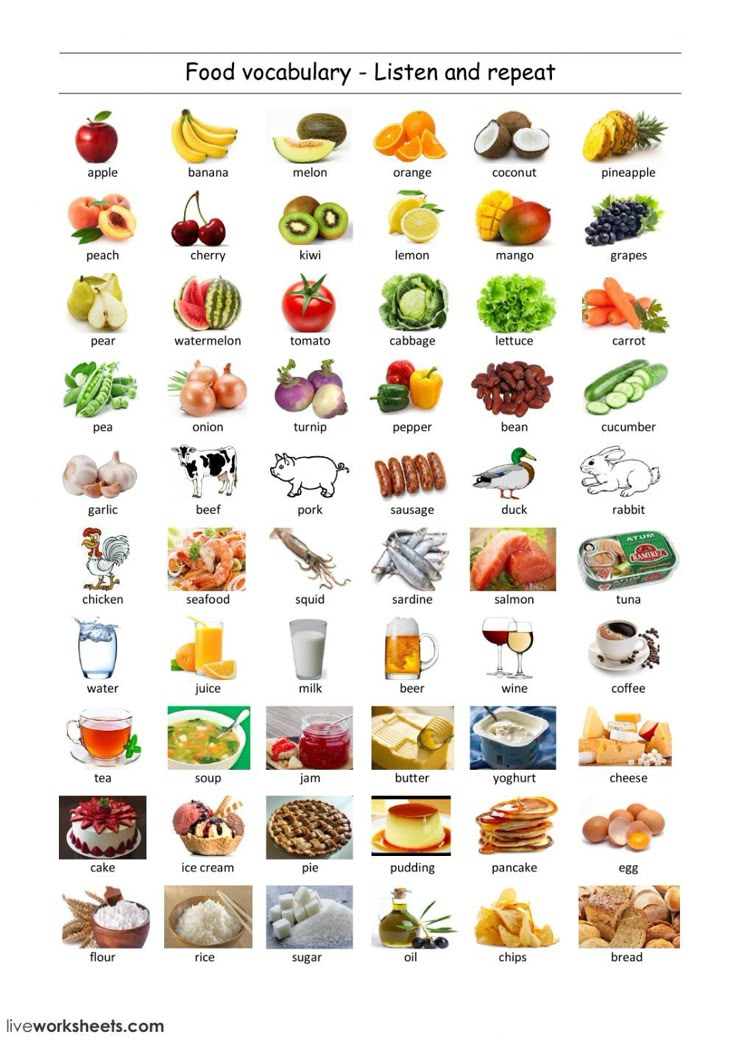 It's also difficult to determine how much an 8-month-old (or older baby) should eat – babies this age are more interested in solid foods but still get most of their nutrition from breast milk or formula. This visual guide to baby food portions can help you figure out how much your baby should eat at every stage.
It's also difficult to determine how much an 8-month-old (or older baby) should eat – babies this age are more interested in solid foods but still get most of their nutrition from breast milk or formula. This visual guide to baby food portions can help you figure out how much your baby should eat at every stage.
Photo credit: Karla Martin for BabyCenter
How much should my baby eat?
Do you worry that your baby is eating too little or too much? Your baby will self-regulate her food intake based on what their body needs, so let their appetite be your guide.
It's helpful to have a reference point, however. Here are photos of how much solid food a baby typically eats in a day. You can also ask your baby's doctor for feeding advice.
This visual guide shows:
- Portions for infants who are new to solids (typically 4 to 6 months)
- Two sample meals for a younger baby (6 to 8 months)
- Three sample meals and two snacks for an older baby (8 to 12 months) from a menu developed by the American Academy of Pediatrics (AAP)
Your little one may eat less or more than what's shown here. Your job is to provide a variety of healthy foods at regular intervals without pressure, and their job is to decide what and how much to eat.
Your job is to provide a variety of healthy foods at regular intervals without pressure, and their job is to decide what and how much to eat.
Photo credit: iStock.com / UntitledImages
Watch for signs your baby is full
Lots of factors – including activity level, growth spurts or plateaus, illness, and teething – will affect your baby's appetite, which can vary daily.
End feeding when they signal that they're done. Signs of being full include:
- Turning their head away
- Refusing to open their mouth for another bite after they've swallowed (resist the urge to encourage your baby to have one last spoonful)
- Leaning back in their chair
- Playing with the spoon or food rather than eating
Photo credit: Karla Martin for BabyCenter
How much a 4- to 6-month-old should eat
When your baby is developmentally ready for solids, typically around 4 to 6 months, talk to their doctor about introducing solid foods. The first bites are mostly about them getting used to the idea of having something different in their mouth.
The first bites are mostly about them getting used to the idea of having something different in their mouth.
- Start with a very small amount, 1 to 2 teaspoons, of a single-ingredient puree.
- Gradually increase to 1 to 2 tablespoons of food once a day.
- Follow your baby's fullness cues.
Popular first foods include pureed mango, banana, chicken, turkey, beef, peas, sweet potatoes, and infant cereal. It's up to you what food to start with, but wait 3 to 5 days between introducing each new food to make sure your baby doesn't have an allergic reaction or food intolerance. (And remember, no cow's milk or honey until age 1.)
Photo credit: Karla Martin for BabyCenter
How much a 6- to 8-month-old should eat
As your little one gets more comfortable with solids, you can increase the frequency of meals and variety of food.
- Transition from one to two meals a day, typically by 8 months.
- Over time, add a second food to each meal.
 The photo above is an example of a meal with two foods.
The photo above is an example of a meal with two foods. - Once you've worked up to two meals with two foods each, aim for a balance of proteins, vegetables, fruits, and grains in their daily diet.
- Whenever you introduce a new food, start with a very small amount, a teaspoon or two, to allow your baby to get used to its flavor and texture.
- Start with a soupy consistency. Gradually add more texture as their eating skills improve.
Expect their intake of breast milk or formula to go down. They'll start drinking less of it as they eat more solid foods. Provide healthy options at mealtimes, and let them choose how much to eat.
Note: The jars in all photos are standard 4-ounce baby food jars.
Photo credit: Karla Martin for BabyCenter
Breakfast for a younger baby (6 to 8 months)
Cereal and fruit make an easy combination for a morning meal.
Grain: Iron-fortified, whole-grain infant cereal is a popular first grain.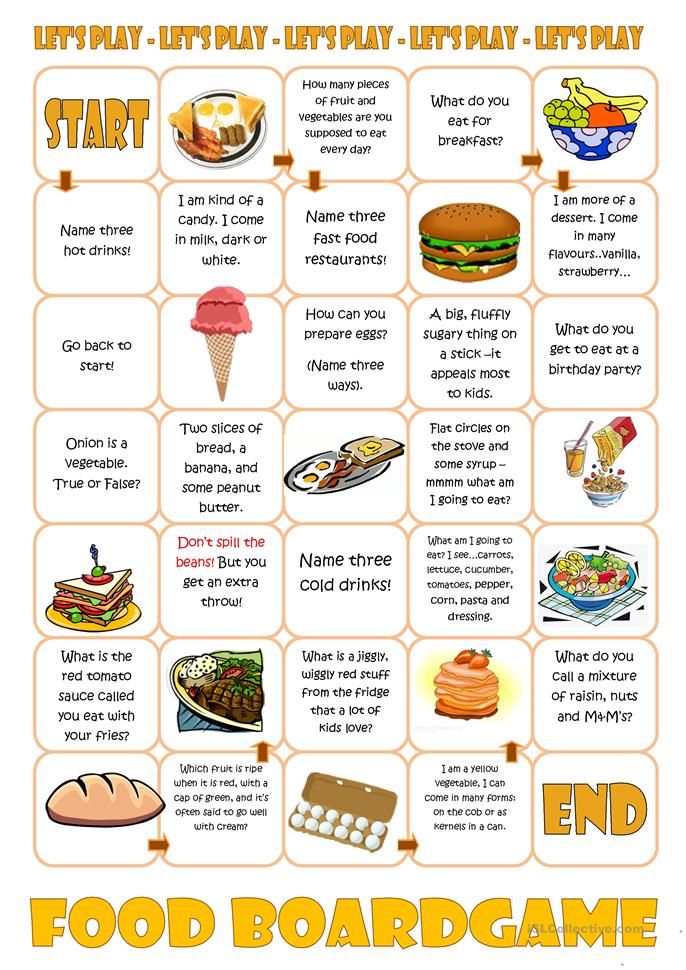 At 6 months, a typical daily portion of infant cereal mixed with breast milk or formula might be 2 to 3 tablespoons, increasing to 4 to 8 tablespoons (1/4 to 1/2 cup) by 8 months. (It's best to avoid rice cereal, though.)
At 6 months, a typical daily portion of infant cereal mixed with breast milk or formula might be 2 to 3 tablespoons, increasing to 4 to 8 tablespoons (1/4 to 1/2 cup) by 8 months. (It's best to avoid rice cereal, though.)
Fruit: Babies love the natural sweetness of fruits like pears, apples, berries, prunes, and stone fruits. Between 6 and 8 months, a baby will typically transition from about 2 to 3 tablespoons of fruit puree a day to 4 to 8 tablespoons (1/4 to 1/2 cup) of mashed or minced fruit.
Photo credit: Karla Martin for BabyCenter
Dinner for a younger baby (6 to 8 months)
If you serve a grain and fruit in the morning, consider offering a protein-rich food and vegetable later in the day. Your child may eat more or less than the amounts shown.
Protein: A baby might transition from eating 1 to 2 tablespoons of meat puree at 6 months to 2 to 4 tablespoons at 8 months, for example. Other good protein sources include cheese, unsweetened plain whole-milk yogurt, tofu, beans, and lentils.
Vegetables: Between 6 and 8 months, a baby will typically transition from about 2 to 3 tablespoons of vegetable puree a day to 4 to 8 tablespoons (1/4 to 1/2 cup). Try classic favorites like carrots, spinach, or butternut squash, as well as less traditional first foods such as parsnips, beets, or asparagus.
As your child's eating skills improve, gradually add more texture by dicing or mincing foods.
Photo credit: Karla Martin for BabyCenter
How much an 8- to 12-month-old should eat
By 8 months or so, your baby is likely getting the hang of eating and needs to eat more calories to support their growing body. But since their little belly can't hold a lot of food, they'll need to eat more often. Every baby is different, but this may be a good time to try offering a third solid food meal.
During this period:
- Continue to give your baby breast milk or formula.
- Add morning and afternoon snacks. (Some babies this age are happy with breast milk or formula as their snack, while others gravitate toward solid foods.
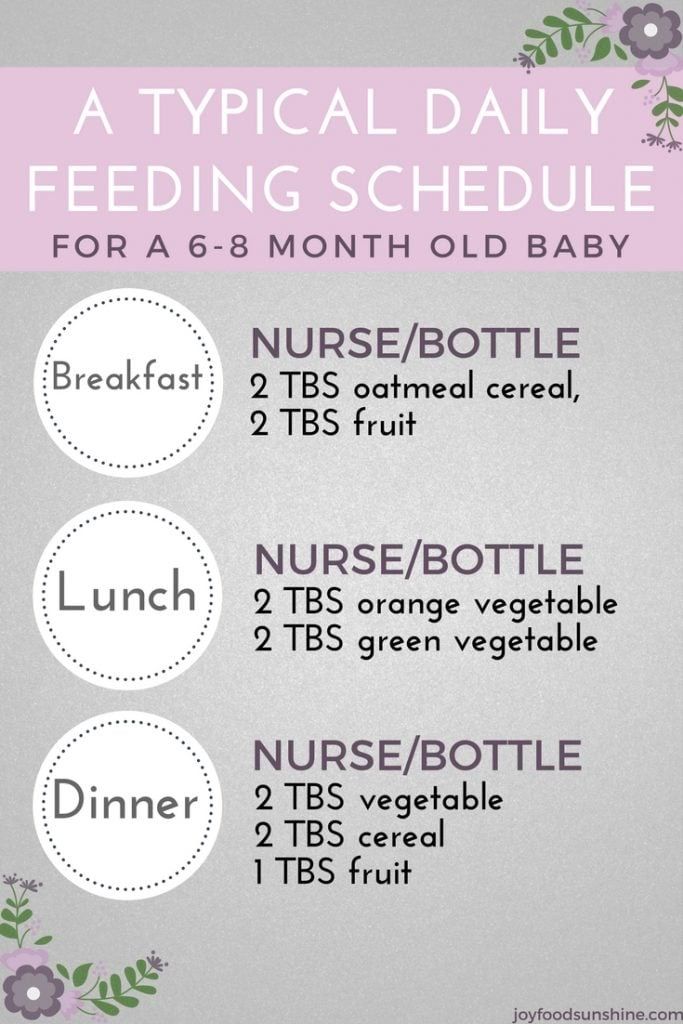 ) Once you've added a third meal and snacks, your baby will be eating or drinking something about every two to three hours.
) Once you've added a third meal and snacks, your baby will be eating or drinking something about every two to three hours.
- Continue to aim for a mix of proteins, vegetables, fruits, and grains.
- Introduce coarser and chunkier textures, for example, by dicing or mincing food instead of pureeing it, and graduate to soft finger foods as your baby's eating skills improve.
- Avoid foods with added sugars. Check the Nutrition Facts label on packaged foods, and try to steer clear of foods that list 1 gram or more of "Added Sugars."
- Provide healthy options, and let your baby choose how much to eat.
To visualize daily portions for an 8- to 12-month-old, check out the following photos of a typical day's menu for a baby this age, developed by the AAP.
Your child may eat more or less than these amounts. If you're concerned about how much your baby is eating, talk to their doctor for advice.
Photo credit: Karla Martin for BabyCenter
Breakfast for an older baby (8 to 12 months)
The AAP sample menu for a baby 8 to 12 months features a breakfast consisting of:
- 4 to 8 tablespoons (1/4 to 1/2 cup) whole-grain infant cereal mixed with formula or breast milk
- 4 to 8 tablespoons (1/4 to 1/2 cup) diced fruit
Note: This is an example.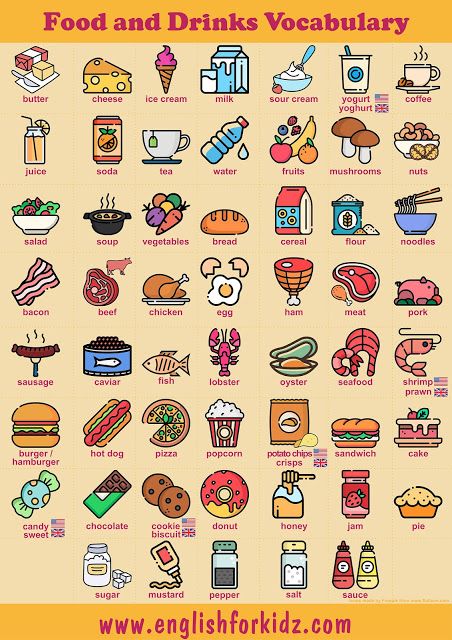 Your baby may eat different foods and amounts.
Your baby may eat different foods and amounts.
Photo credit: Karla Martin for BabyCenter
Morning snack for an older baby (8 to 12 months)
The AAP sample menu for a baby 8 to 12 months features a morning snack consisting of:
- 4 tablespoons (1/4 cup) diced cheese or cooked vegetables
Note: This is an example of a morning snack, which babies typically add sometime between 8 and 12 months. Your baby may eat different foods and amounts.
Photo credit: Karla Martin for BabyCenter
Lunch for an older baby (8 to 12 months)
The AAP sample menu for a baby 8 to 12 months features a lunch consisting of:
- 4 to 8 tablespoons (1/4 to 1/2 cup) unsweetened plain whole-milk yogurt or cottage cheese, or minced meat
- 4 to 8 tablespoons (1/4 to 1/2 cup) diced or mashed yellow or orange vegetable
Note: This is an example. Your baby may eat different foods and amounts.
Photo credit: Karla Martin for BabyCenter
Afternoon snack for an older baby (8 to 12 months)
The AAP sample menu for a baby 8 to 12 months features an afternoon snack consisting of:
- 4 tablespoons (1/4 cup) diced fruit or unsweetened plain whole-milk yogurt
- 1 whole-grain teething biscuit or cracker
Note: This is an example of an afternoon snack, which babies typically add sometime between 8 and 12 months.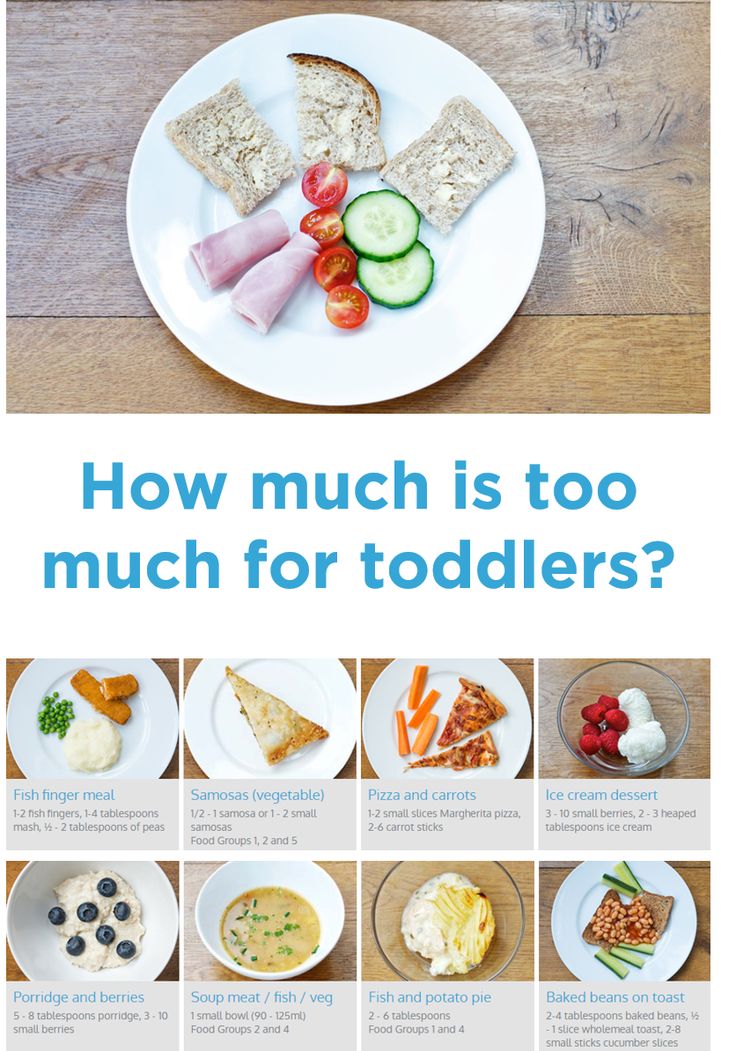 Your baby may eat different foods and amounts.
Your baby may eat different foods and amounts.
Photo credit: Karla Martin for BabyCenter
Dinner for older baby (8 to 12 months)
The AAP sample menu for a baby 8 to 12 months features a dinner consisting of:
- 4 tablespoons (1/4 cup) minced or ground poultry or meat, or diced tofu
- 4 to 8 tablespoons (1/4 to 1/2) cup diced, cooked green vegetable
- 4 tablespoons (1/4 cup) noodles, pasta, rice, or potato
- 4 tablespoons (1/4 cup) diced fruit
Note: This is an example. Your baby may eat different foods and amounts.
Photo credit: Karla Martin for BabyCenter
How much should my baby drink once they start eating solids?
Breast milk or formula will fully meet your child's hydration needs until they're about 6 months old. They may start drinking less as solid foods become a bigger part of their diet. Here are typical daily amounts by age – your baby's intake may be different, however.
6 to 8 months: 24 to 32 ounces of formula, or continued breastfeeding on demand
8 to 12 months: 24 ounces of formula, or continued breastfeeding on demand
Water: You can offer your baby water once they start eating solids, but let them self-regulate how much they drink. The Centers for Disease Control and Prevention (CDC) recommends giving babies who are 6 to 12 months old 4 to 6 ounces of water a day, but what your baby decides to drink may vary. They may drink more on a hot day, for example.
Avoid juice: Juice isn't recommended for babies younger than 12 months.
Photo credit: iStock.com / SDI Productions
Your baby has the final say
Keep in mind that these portions are an estimate. The truth is, every baby is different, and there's no set amount of food that's appropriate for every baby at every stage.
If you're worried about whether your baby is eating enough – or too much – the best advice is to look for and respond to signs that your baby is full.
Your baby's doctor will chart their weight gain at regular intervals. If the doctor sees a consistent growth curve and doesn't have other concerns, your baby is most likely eating the right amount of food.
Hungry for more?
Age-by-age guide to feeding your baby
The 10 best foods for babies
The worst foods for babies
Using spices and seasoning in baby food
Was this article helpful?
Yes
No
Elizabeth Dougherty
Elizabeth Dougherty is a veteran parenting writer and editor who's been contributing to BabyCenter since 2015. She's an intrepid traveler, devoted yogi, and longtime resident of Silicon Valley, where she lives with her husband and son.
Advertisement | page continues below
Advertisement
Union of Pediatricians of Russia
Nutrition for children from 1 to 3 years of age
The period from 1 to 3 years of life is a crucial stage in the transition to an adult type of nutrition, which has certain features. In order to ensure that all the necessary nutrients enter the child's body and at the same time prevent an excess of individual nutrients, nutrition should be balanced and varied.
In order to ensure that all the necessary nutrients enter the child's body and at the same time prevent an excess of individual nutrients, nutrition should be balanced and varied.
The daily amount of food for children aged 1 to 1.5 years should be 1000-1200 g, from 1.5 to 3 years - 1200-1500 g, the amount of food in one feeding should not exceed 300-350 ml. The diet consists of three main meals per day and two snacks. It is considered optimal when breakfast is 25% of the total energy density of the diet, lunch is 30–35%, dinner is 20%, and additional meals are about 10%. In general, the child can eat the same food as the rest of the family.
In the diet of a child of 1–3 years of age , must be present daily: meat of animals or poultry, dairy and sour-milk products, vegetables, fruits, bread, cereals, vegetable and butter; fish and eggs are included in the diet 2-3 times a week.
Cereal products: bread - 2-3 servings per day, cereals and side dishes - 1 time per day
Fruit and/or vegetables: at least 5 times a day
Dairy products: at least 3 servings per day (including those used to make cereals, yoghurts, fermented milk drinks, cottage cheese, infant formula or breast milk).
Domestic pediatricians recommend, when compiling a diet for children aged 1–3 years, preference should be given to specialized children's dairy products of industrial production that meet high quality requirements and safety indicators for this age. Most children's dairy products are additionally enriched with vitamins and/or minerals and other biologically active components, taking into account the physiological needs of children of this age. At the same time, in foreign recommendations, children over 1 year old are offered the gradual introduction of whole cow's milk, which is rich in fats necessary for proper growth and development, the absorption of vitamins A and D, the development of the brain and nervous system of the child.
Meat dishes: 2-3 times a day
Fish dishes: 2-3 servings per week
Eggs: 2-3 per week
Dietary fats: 3-4 teaspoons of butter and/or vegetable oils per day
When cooking, use the minimum amount of salt and sugar, and do not add them to industrial products.
Offer your child a variety of foods and let them choose for themselves. Children love to eat on their own, so if possible, offer food that the child can eat with their hands.
It is important to remember that a baby can choke on pieces of food, so whatever you give your baby should be crushed or cut into small pieces that can be easily chewed.
Do not give to a small child: nuts, whole grapes, cherry tomatoes (unless quartered), whole carrots, seeds (such as pumpkin or sunflower seeds), round candies, legumes, raisins, because a child can eat them choke.
Also in the diet of children of the first 3 years of life should not be present:
Mushrooms; canned snacks, pickled vegetables and fruits
Home canned food
Dry concentrates for side dishes
Hot sauces, mustard, horseradish, pepper, vinegar, mayonnaise
Natural coffee
Juices and drinks in the form of dry concentrates; sweet carbonated drinks
Products containing food additives (flavorings, dyes of artificial origin, including chewing gum), popcorn
Combined fats; cakes and pastries
It is important to remember that children of this age should not be given too spicy and spicy foods.
4-7 year old child - Tarkvanem ‹ Meals - Tarkvanem
Main page / Meals / 4-7 year old child
Lateral navigation
As the child grows older, he becomes more independent. This is expressed in his eating habits and food choices. Certain food preferences have formed, he wants to choose more himself, decide what he will eat.
A child's energy and nutrient requirements per kilogram of body weight are still very high, which on the other hand means careful planning of the menu to get everything they need from food.
From soft drinks, potato chips, sweets, buns and cakes, the child receives a lot of empty energy, which is enough or too much to meet the energy needs, but at the same time, he remains without other foods (fruits and vegetables, bread, milk , fish, etc.), which are needed to obtain proteins, fatty acids, vitamins and minerals necessary for life.
Dietary recommendations for children over 2 years of age are similar to adults, but since children have lower energy requirements, the recommended amount of food also decreases proportionately.
Meals
Children should have 3 main meals and 1-2 snacks per day.What kind of food and how many times to give at home depends on the time the child spends in the child care facility. The body needs to be regularly provided with the necessary amount of energy, so it is important to stick to daily meals.
Breakfast is the most important meal of the day - it supplies the body with energy so that the child can start playing or learning. If the child goes to kindergarten, weekday breakfasts must be adapted according to whether the child eats breakfast in the garden and what time he eats it. Breakfast does not need to be eaten immediately after waking up, but it is useful to have breakfast within an hour.
Snacks should be minimally processed (eg, fresh or dry fruits and berries, vegetables, unflavored yogurt and cottage cheese, bread, juice, oatmeal, sandwiches). Sweets, crackers, cookies, soft drinks, juice drinks, ice cream, etc. are not suitable as snacks. Even one candy or cookie between meals can ruin a child's appetite for the whole day. Do not give your child food as a prize or consolation, or if the child is bored.
are not suitable as snacks. Even one candy or cookie between meals can ruin a child's appetite for the whole day. Do not give your child food as a prize or consolation, or if the child is bored.
Lunch and dinner can be heavy, especially lunch . Soups and a slice of bread with soup go very well, as well as a dessert using a minimum amount of sugar, or even a small second. The younger the child, the more you need to use stewing-boiling in cooking his food. Perfect for a variety of casseroles. Since children want to see what ingredients food is made of, teaching a child to eat mixed dishes from infancy can hide vegetables in them that children do not really like. For dinner, a dense vegetable salad is suitable, in which you can add an egg, cheese, fish, meat, homemade cheese, or something else. If the child eats properly in the garden, the food offered at home should not be very energy intensive.
Dinner should be a specific time when the family eats together and where they can talk about the day's events and be together (rather than watching TV or a computer screen at the same time).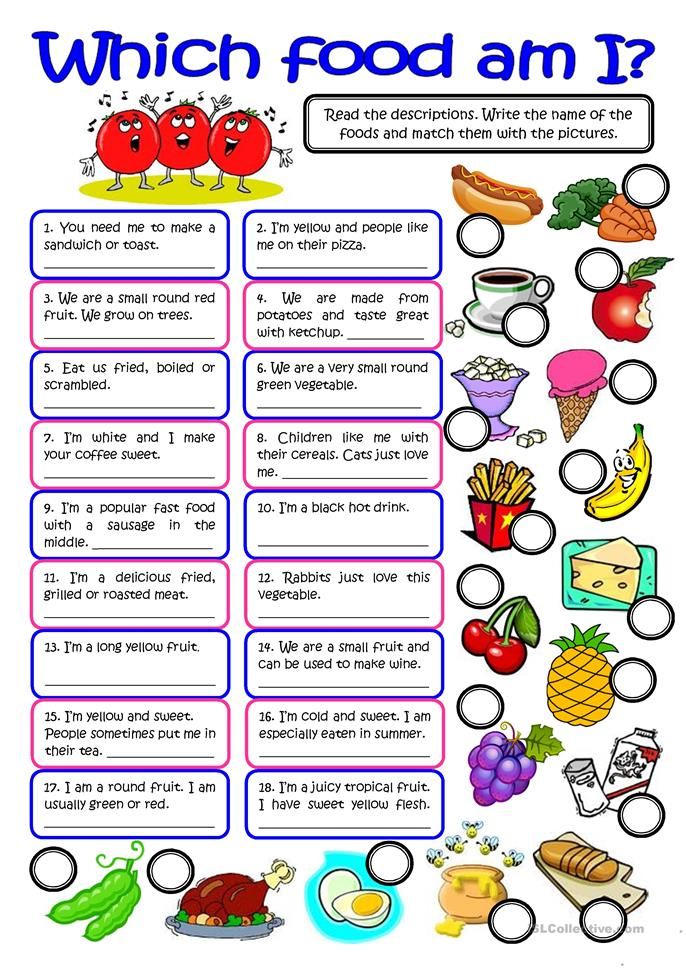 Here you can discuss the menu for the next day, as well as prepare for the weekend.
Here you can discuss the menu for the next day, as well as prepare for the weekend.
- A child should be taught to eat right and healthy from an early age. Habits formed in childhood often influence the choices we make later in life. Some children are quite selective in terms of what he eats and what not; It is important that you, as a parent, be an example to your child and encourage and support healthy eating habits.
- Young children in their food preferences are guided by two main factors - whether they are familiar with food and the taste of food (sweetness).
 Therefore, new products must be introduced carefully and in small quantities, leading by example. Getting used to new foods takes time. If you do it carefully and in a playful way, the children will be very interested.
Therefore, new products must be introduced carefully and in small quantities, leading by example. Getting used to new foods takes time. If you do it carefully and in a playful way, the children will be very interested. - The more natural flowers will be presented on the plate, the more beautiful and appetizing the dish will be, the more it will contain various essential nutrients.
- When eating, the child's mood and environment are important (for example, whether the TV is playing or there are guests), as well as whether the child is hungry.
- For eating, it is imperative to set aside time to enjoy food. When eating together with the family, the child will eat faster, the example of parents is important from early childhood. Enjoy each other's company while eating.
- Appearance and correct food temperature are important for a child. The child will eat with great appetite if he sees what ingredients the food was prepared from. Try different foods and cook them in different ways to ensure food variety and availability of different nutrients.

- Teach your child to choose foods from different food groups so that he understands what a variety of food is. Give your child the opportunity to choose their own food from suitable foods: this or that fruit, various grains, various vegetables, etc. Teach children to eat plenty of vegetables from an early age.
- Offer water instead of juice to quench your thirst.
- A child should never be scared about food. Food is not a means of punishment or reward. Do not force the child to eat, rather attract. If you force a child to eat, it greatly affects the psyche and behavior of the child and can leave a negative imprint on his entire subsequent life.
The most important child nutrition keywords:
- example
- joint meal
- availability of suitable food
- explanatory work
- time
- choice and decision making
- An example is one of the factors that will begin to shape the nutrition of a young child.
 The younger the child, the more influence on his choice of food is the example of parents and siblings. As the child matures, friends and the environment become more influential.
The younger the child, the more influence on his choice of food is the example of parents and siblings. As the child matures, friends and the environment become more influential. - A child's eating habits are shaped by what food choices are available to the family (including the child) (both financially and based on the parents' knowledge), how meals are organized at home, etc.
- Many children aged 4-7 go to kindergarten, and often spend time at home only in the evenings or on weekends. These meals should form a conscious choice. Children can discuss with children and direct their nutritional wishes.
Children grow in periods, which means that there may be times when the child eats too little, and there are periods when he eats more.
- It is useful to ensure that food intake and energy expenditure are balanced.
- If the child is very active, he should eat more.
- If the child seems to be eating too little or too much, keep a food diary - for about a week, write down everything that and how much the child ate and drank.

- It often turns out that the problem is not in the quantity eaten, but in the choice of food. After all, you can get as much energy from a couple of candy cookies as from a good portion of soup.
- It is unwise to immediately grab a jar of vitamins and minerals, you should reconsider nutrition - sufficient, balanced and varied nutrition will provide the necessary substances.
- The only exception is vitamin D, which all children should receive as a dietary supplement.
- If a child has access to a varied and balanced diet, he grows and develops according to his age, there is no cause for concern. If parents still feel that the child may not be getting all the necessary nutrients in sufficient quantities, from time to time blood tests can be done by a doctor to check the health.
- Candy or biscuits should never be given to children as a consolation, reward, or dispersal of boredom - on a subconscious level, this may affect his eating habits in the future.
 Avoid bringing sweets (candy, cookies) home and keep them in a conspicuous place. Instead, put peeled-cut fruits and vegetables on the table.
Avoid bringing sweets (candy, cookies) home and keep them in a conspicuous place. Instead, put peeled-cut fruits and vegetables on the table. - Nuts and dried fruits and berries are suitable for satisfying the desire to eat something sweet, but one should not be too zealous with them either. Nuts can only be given to young children in a ground or highly chopped form, as well as to both young children and older children so that children do not have an allergic reaction to them.
- Clean water should always be available to quench thirst. You can drink up to two glasses of juice per week. If necessary, dilute the juice yourself, do not buy nectars, juice drinks and syrups in the store, not to mention soft drinks.
- Although vitamin-fortified water is thought to help you get enough vitamins, one 750 ml bottle actually contains approximately 40 grams of sugar, which is the daily dose of sweets for an adult.
- A varied, balanced and regular diet (including cereals, fruits and vegetables, and other food groups) ensures sufficient intake of vitamins, minerals and macronutrients, as well as energy and reduces the desire to eat something sweet.

- It is very likely that an obese child will grow into an obese adult.
- Increasingly, overweight and obesity are already occurring in young children.
- This risk can be reduced through informed food choices and sufficient exercise.
- With food you need to get as much energy as it is consumed. Therefore, foods rich in energy, but poor in vitamins and minerals (for example, sweets, cookies, buns, cakes, soft drinks, potato chips, etc.) should be eaten as little as possible.
- Food choices should be as varied as possible, including whole grains, vegetables and fruits, as well as berries, unsweetened dairy products, fresh fish, poultry, meat and eggs, nuts and seeds.
- The child must be physically active (in the house and in the yard) for at least 60 minutes a day, even more is better.
- To check whether the child is growing and gaining weight normally, you can look at the growth and weight curve of infants and children, and in case of underweight or overweight, it is imperative to consult a family doctor or pediatrician for further instructions.
 You can not limit the nutrition of the child, guided by their own ideas.
You can not limit the nutrition of the child, guided by their own ideas.
Kindergarten children often eat out three times a week - breakfast, lunch and dinner.
According to how much time the child spends in kindergarten, how many times and what he eats, it is necessary to form the child's home meals. The body needs to be regularly provided with the necessary amount of energy, so it is important to stick to daily meals.
Keep up to date with the weekly kindergarten menu, create different options for homemade dinners or weekend lunches. Also ask teachers if the child ate in the garden and how much he ate from what was offered, take this data into account when serving homemade dinner.
The more flavors and foods you introduce to your child from an early age, the easier it will be for them to get used to food in kindergarten.
In Estonia, food regulations have been developed in pre-school child care institutions, which are regulated by an order of the Minister of Social Affairs.
Too many meals offered to children often include too much salt or sugar. Children's meals may appeal to children (often due to their high fat, sugar and/or salt content), but their nutritional value is often very low. Instead of children's meals, it is better to choose a regular dish or soup and ask for it to be prepared with as little salt as possible.
Fast foods also tend to be high in energy (and high in fat, sugar and/or salt). For example, from one small cheeseburger, small fries and 250 ml of cola, a child can get about 650 kcal, which is about 40% of the daily energy requirement of a 7-year-old child with an average activity. Salt in this choice contains a little more than is acceptable per day (children aged 2-9 years can receive no more than 4 grams of salt from all sources per day). A soft drink contains just over 25 grams of sugar, which is also more than half of the maximum allowable daily amount of sugars. If you absolutely want to offer such food to a child, this is possible no more than twice a year, and then if the daily diet is in order.
- Depending on the age of the children invited to the birthday, when choosing food for the festive table, you can be guided by recommendations for their age.
- The food offered at the birthday party must be prepared from minimally processed raw materials. The less sweets, soft drinks, potato chips and other similar foods on the festive table, the better. If there is a rich and convenient selection of fruits and vegetables on the festive table, and the children have something to do, the children will not even remember that such food exists.
- First of all, it is great for children (especially if the birthday is not at home, but in some kind of playroom) sliced vegetables such as carrots, paprika, cucumber and cauliflower with homemade unflavored yogurt dip sauce.
- You can offer fruit on a skewer (melon, pear, watermelon, grapes).
- If desired, you can prepare more dense dishes (salads, homemade pizza, etc.), but they must be prepared from minimally processed raw materials.

- If you offer baked goods, try to find low sugar options (raw sugar, agave syrup, etc. are not good alternatives).
- If there are only a few children's birthdays in which the child participates in a year, on this day you can "sin" a little and offer the children a little more food to their taste, for example, meatballs, sausages, oven-cooked french fries, popcorn without salt. But this, again, provided that on other days the choice of food corresponds to the recommendations.
- Always read the label on food packaging! This will help you make a more informed choice.
- The allowable amount of supplements for children is usually less than for adults (the maximum amount is based on adult body weight). Therefore, be careful with colored sweets, drinks, cookies with a long shelf life, desserts and sausages, products containing synthetic sweeteners.
- If the child is old enough to participate in the grocery shopping, let the child choose between suitable foods: one or another fruit, various cereal products, various vegetables, etc.

- Avoid the shelves with sweets, biscuits, soft drinks, etc., so that the child does not have a desire to buy sweets.
- If a child in a grocery store always asks for candy, etc., then it is better to go there without the child or take the child to the store when he grows up and understands what and when is bought in the store.
- Always go to the store on a full stomach, with a shopping list, and avoid impulse purchases.
The less time preschoolers spend watching television and gadgets, the better.
The use of gadgets and watching TV is not recommended while eating, as it diverts attention from eating as a process. In turn, this forms the wrong eating habits in children.
While eating, all attention should be paid to the process of eating.
- The principle of a healthy lifestyle is that the amount of energy received from food and the amount of energy expended are in balance.
- All children should be as active as possible from an early age.
 Parents themselves should orient their children to the movement, be an example to them.
Parents themselves should orient their children to the movement, be an example to them. - The child must be physically active (in the house and in the yard) for at least 60 minutes a day, even more is better.
- Mobility habits formed in childhood are the basis for adult mobility habits.
- If the child is more active (for example, goes to some kind of training), his need for energy is higher due to the energy expended. The additional energy requirement cannot be covered by the energy obtained from sweets and fast food; nuts and seeds can be added to the menu.
- Before eating and preparing food, you and your baby should always be thoroughly washed to prevent possible micro-organisms causing disease from getting into the stomach. If food is interrupted (for example, due to a trip to the toilet), hands should be washed again before continuing to eat.
- Teeth should be taken care of already in infancy. Children of early age brush their teeth with clean water and a soft brush.
